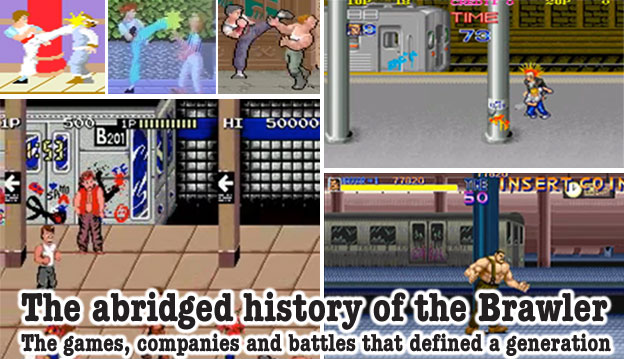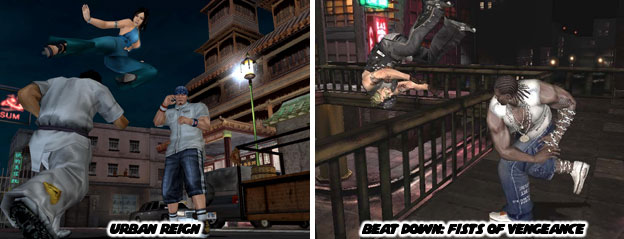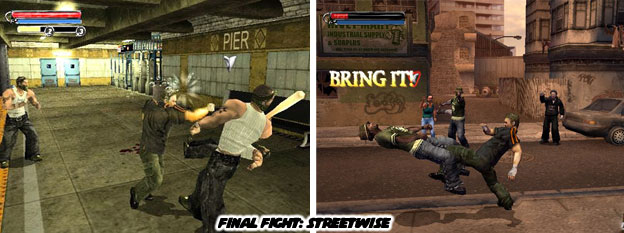
In 2005 games were becoming dark and brooding, they were following the trends from other studios as well as from cinema. The bright colors and over-the-top designs from brawlers in the early 90's seemed passé. In order to appeal to players the characters had to be dark and gritty. The universes they were set in also had to be dark and ugly. Hence the new Capcom brawler from that year, Beat Down: Fists of Vengeance, was one of the darker and more violent games they've ever produced.
Beat Down was designed to be an online brawling game, with a customization feature, complex story and various locations characters could visit. It was a brawler with RPG and MMO elements. However it did not capture the gamer's imagination. The characters looked like generic bruisers, an exercise in pop character design for an art college class. Guys and girls wearing leather and sporting tattoos seemed enough to make them tough characters. They lacked the archetypical traits that made the Final Fight cast so memorable. Capcom had rewritten the book on brawlers through the 90's and in the new decade had released a cast that lacked presence in a game that was average at best.

Capcom did not get off on the right foot while rival developer Namco faired slightly better. Urban Reign by Namco was their first 3D brawler and it was a good game. While Capcom was mastering 2D animation in their fighting games through the 90's Namco had been building a franchise in 3D technology. The programming experience that they had developed through the Tekken series was paying off for the publisher. The lessons they learned in arcade development was quickly translated for the Playstation platforms. They were among the first studios to have a version of Tekken available on the original Playstation and Playstation 2. With Urban Reign they saw potential for the Tekken engine beyond the traditional 1-on-1 fighting game. Specifically the Tekken 5 engine worked quite well for a brawling game for the PS2. It worked so well that it was also used in Death by Degrees the action game released the same year featuring Nina Williams, also from the Tekken fame.
Urban Reign featured a cast of distinct archetypes including a karate fighter, a street brawler and a female martial arts master. Visually they had greater diversity than the cast in Beat Down. The game was dark and gritty as well, but not as depressing as the world from Beat Down. From a gameplay POV the camera system drew far enough away for players to keep an eye on opponents as well as teammates and did not suffer from the blind spot problems from SpikeOut. The moves and control worked well within the 3D environments Players could set up special attacks and even perform double team attacks on multiple as well as single opponents with relative ease. Some of the double team attacks were spectacular, like the high risk moves from pro wrestling. Those familiar with the Tekken series could see where moves and animations were placed on the new models.

The game had a bonus feature in that any defeated character, including bosses, could be unlocked and played as in a fighting game format. Tekken characters were hidden in the game and could be unlocked for the fighting game portion as well. As well as it was done it faired only slightly better with gamers than Beat Down. The 3D brawling genre just could not gain momentum in arcades or home consoles. What Capcom did next would harm their reputation more than help it. Final Fight: Streetwise was a sequel to the arcade classic. It was the antithesis of everything that made the original brawler legendary. It was dark, ugly, slow, cumbersome and brooding. The controls lacked the simplicity and finesse of the original title, making it less accessible to gamers. Capcom's Production Studio 8, a US-based developer released the abysmal title in 2006, just a year after Beat Down failed to impress audiences.
The designs featured in the title were another exercise in character interpretation, possibly from some art college graduates not old enough to remember the original title. The new versions of the characters were as dark as the premise. A washed-up Cody was reunited with his (surprise!) brother to try and clean up the streets of Metro City from a new drug. The game was bad on all fronts and the attempts to make it visceral and adult just hurt the reputation of the arcade classic. Characters and situations like the infamous Weasel scene did nothing to help the genre or make it relevant to gamers. It was ugly, sloppy and classless design from the former masters of the genre. Thankfully Capcom would stop trying to reboot franchises and instead focus on releasing their actual brawling classics on the Playstation Network and Xbox Live Arcade in latter years.
There was one western studio that did manage to get the genre right, and also give players a compelling 3D experience without the problems suffered by previous brawlers. Rockstar released The Warriors in 2005. The game was based on the 1979 movie about a small gang trying to get past rival gangs through New York en route to their home turf on Coney Island. Rockstar managed to capture the spirit of the movie by recreating the details in the film and then expanded that universe through careful, period piece, interpretations. The game featured a more open ended sandbox-style gameplay than other brawlers. A modified version of the Grand Theft Auto III engine served as the backbone. There were no invisible walls, or camera problems that plagued earlier 3D fighting attempts. A brawler without a countdown clock, or facing nonsensical gigantic level bosses was a refreshing change of pace for gamers. The gang warfare highlighted in the Warriors brought back the energy and emotions that classic brawlers once pulled from gamers. It could appeal to fans of the GTA series without including all of the vehicle and mission hijinks featured in that game. Rockstar redefined the genre by ignoring convention and earned the praise of gamers and critics alike.
Five years later Rockstar released an Xbox Live Arcade version of the game that limited all of the play elements to the traditional format. The Warriors Street Brawl from 2010 used a fixed, side-scrolling camera, with 3D characters. The game did introduce a "store" to the genre where players could buy weapons and upgrades for their characters, but it failed to win over new fans. Street Brawl lacked the substance of the previous sandbox experience and if anything highlighted the deficiencies of the classic format with modern visuals. Without Sega, Capcom or Konami developing new brawlers after 2006 the genre would only be kept alive by independent studios. Many experiences faded away but at least one became an example of what still worked in the genre. Find out about the first major attempt at a brawling MMO as well as the little title that became a smash hit in the next blog. As always if you enjoyed this blog and would like to sponsor me please visit my Patreon page and consider donating each month, even as little as $1 would help make better blogs and even podcasts!

No comments:
Post a Comment